Information Technology's Impact on Organizational Performance
VerifiedAdded on 2021/02/19
|9
|2940
|1038
Report
AI Summary
This report delves into the critical role of Information Technology (IT) in contemporary business environments, examining its impact on organizational success and failure. It explores the significance of IT in managing complex retail operations, emphasizing market knowledge and data control. The report analyzes the benefits and drawbacks of outsourcing ICT, the social and ethical issues in running a business, and the differentiation between various network technologies like LAN and WAN. Furthermore, it discusses the benefits and uses of the internet and intranet within a business context, along with the stages of the system development life cycle (SDLC). The report also includes an analysis of the advantages and disadvantages of organizational investments in IT, providing insights into how businesses like Tesco leverage IT for competitive advantage and operational efficiency. Overall, the report underscores the importance of ethical business practices and open communication in the 21st-century business landscape.
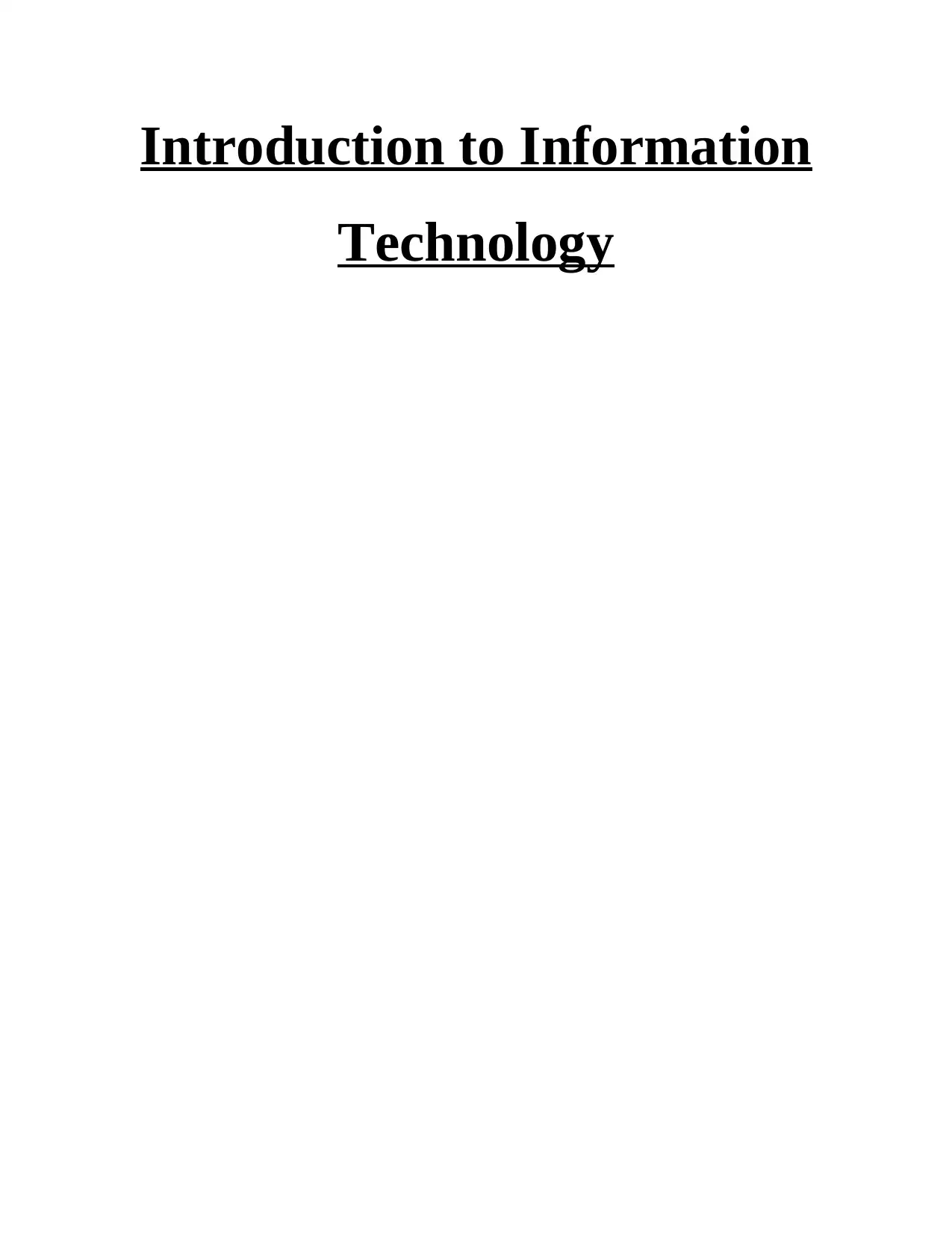
Introduction to Information
Technology
Technology
Paraphrase This Document
Need a fresh take? Get an instant paraphrase of this document with our AI Paraphraser
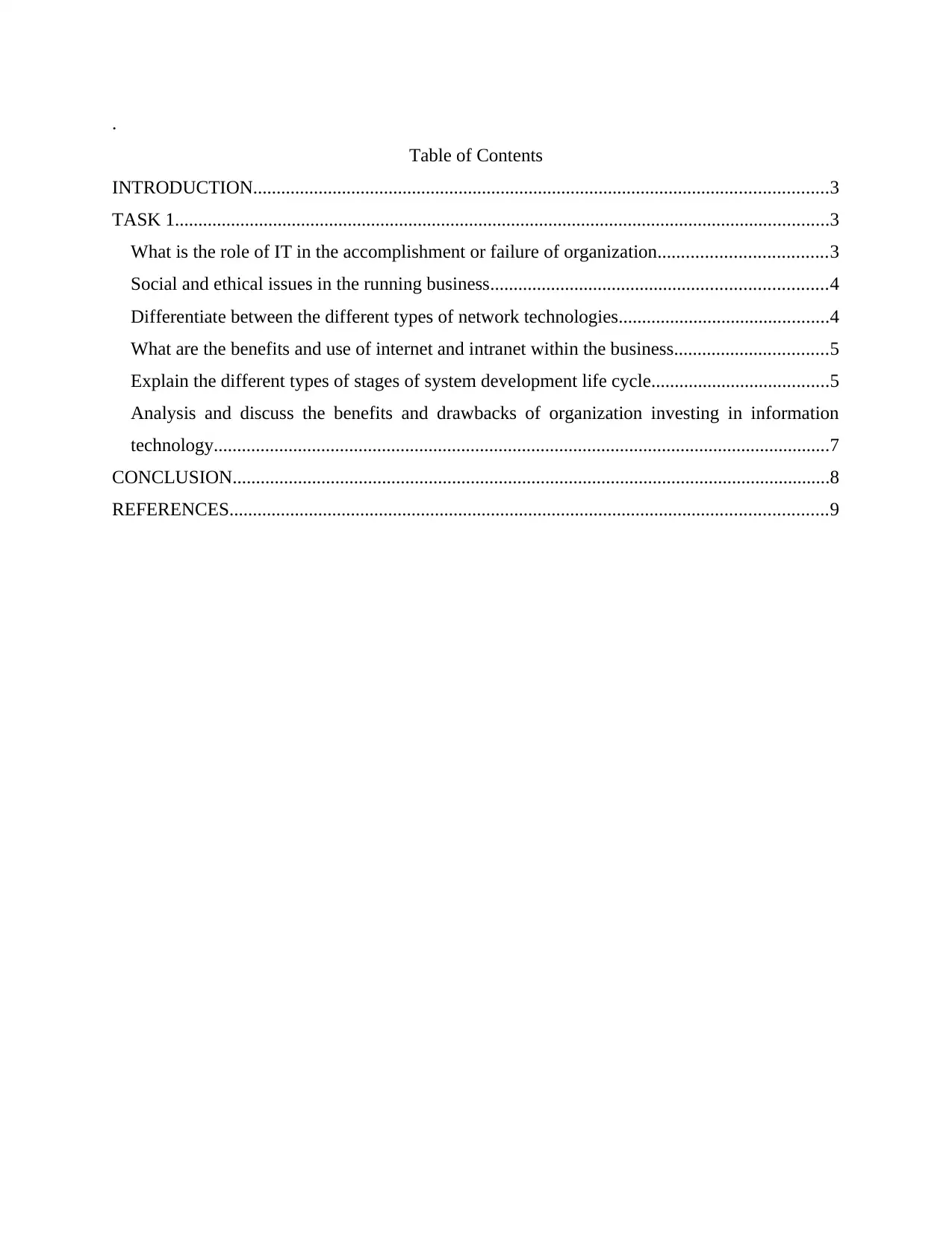
.
Table of Contents
INTRODUCTION...........................................................................................................................3
TASK 1............................................................................................................................................3
What is the role of IT in the accomplishment or failure of organization....................................3
Social and ethical issues in the running business........................................................................4
Differentiate between the different types of network technologies.............................................4
What are the benefits and use of internet and intranet within the business.................................5
Explain the different types of stages of system development life cycle......................................5
Analysis and discuss the benefits and drawbacks of organization investing in information
technology....................................................................................................................................7
CONCLUSION................................................................................................................................8
REFERENCES................................................................................................................................9
Table of Contents
INTRODUCTION...........................................................................................................................3
TASK 1............................................................................................................................................3
What is the role of IT in the accomplishment or failure of organization....................................3
Social and ethical issues in the running business........................................................................4
Differentiate between the different types of network technologies.............................................4
What are the benefits and use of internet and intranet within the business.................................5
Explain the different types of stages of system development life cycle......................................5
Analysis and discuss the benefits and drawbacks of organization investing in information
technology....................................................................................................................................7
CONCLUSION................................................................................................................................8
REFERENCES................................................................................................................................9
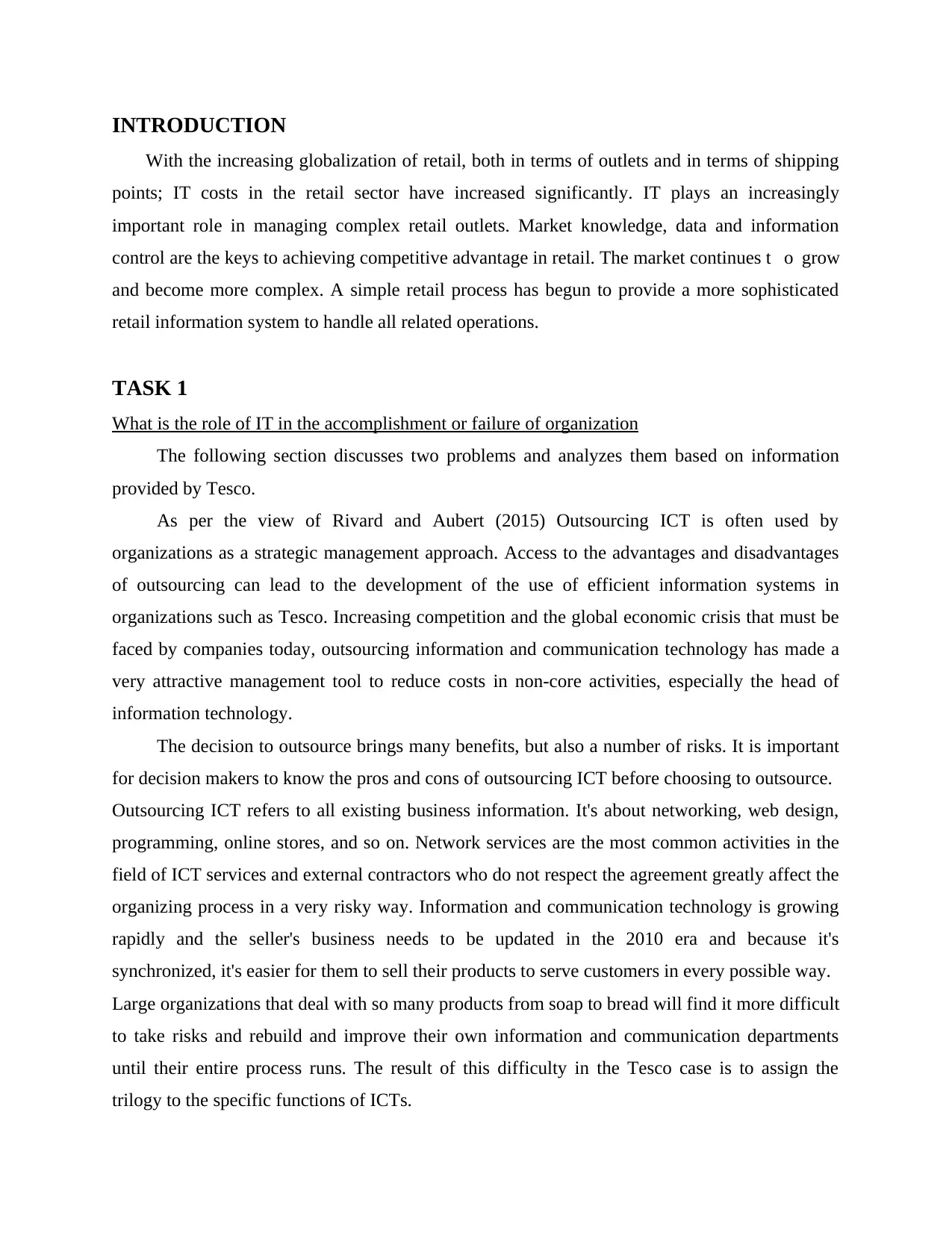
INTRODUCTION
With the increasing globalization of retail, both in terms of outlets and in terms of shipping
points; IT costs in the retail sector have increased significantly. IT plays an increasingly
important role in managing complex retail outlets. Market knowledge, data and information
control are the keys to achieving competitive advantage in retail. The market continues t o grow
and become more complex. A simple retail process has begun to provide a more sophisticated
retail information system to handle all related operations.
TASK 1
What is the role of IT in the accomplishment or failure of organization
The following section discusses two problems and analyzes them based on information
provided by Tesco.
As per the view of Rivard and Aubert (2015) Outsourcing ICT is often used by
organizations as a strategic management approach. Access to the advantages and disadvantages
of outsourcing can lead to the development of the use of efficient information systems in
organizations such as Tesco. Increasing competition and the global economic crisis that must be
faced by companies today, outsourcing information and communication technology has made a
very attractive management tool to reduce costs in non-core activities, especially the head of
information technology.
The decision to outsource brings many benefits, but also a number of risks. It is important
for decision makers to know the pros and cons of outsourcing ICT before choosing to outsource.
Outsourcing ICT refers to all existing business information. It's about networking, web design,
programming, online stores, and so on. Network services are the most common activities in the
field of ICT services and external contractors who do not respect the agreement greatly affect the
organizing process in a very risky way. Information and communication technology is growing
rapidly and the seller's business needs to be updated in the 2010 era and because it's
synchronized, it's easier for them to sell their products to serve customers in every possible way.
Large organizations that deal with so many products from soap to bread will find it more difficult
to take risks and rebuild and improve their own information and communication departments
until their entire process runs. The result of this difficulty in the Tesco case is to assign the
trilogy to the specific functions of ICTs.
With the increasing globalization of retail, both in terms of outlets and in terms of shipping
points; IT costs in the retail sector have increased significantly. IT plays an increasingly
important role in managing complex retail outlets. Market knowledge, data and information
control are the keys to achieving competitive advantage in retail. The market continues t o grow
and become more complex. A simple retail process has begun to provide a more sophisticated
retail information system to handle all related operations.
TASK 1
What is the role of IT in the accomplishment or failure of organization
The following section discusses two problems and analyzes them based on information
provided by Tesco.
As per the view of Rivard and Aubert (2015) Outsourcing ICT is often used by
organizations as a strategic management approach. Access to the advantages and disadvantages
of outsourcing can lead to the development of the use of efficient information systems in
organizations such as Tesco. Increasing competition and the global economic crisis that must be
faced by companies today, outsourcing information and communication technology has made a
very attractive management tool to reduce costs in non-core activities, especially the head of
information technology.
The decision to outsource brings many benefits, but also a number of risks. It is important
for decision makers to know the pros and cons of outsourcing ICT before choosing to outsource.
Outsourcing ICT refers to all existing business information. It's about networking, web design,
programming, online stores, and so on. Network services are the most common activities in the
field of ICT services and external contractors who do not respect the agreement greatly affect the
organizing process in a very risky way. Information and communication technology is growing
rapidly and the seller's business needs to be updated in the 2010 era and because it's
synchronized, it's easier for them to sell their products to serve customers in every possible way.
Large organizations that deal with so many products from soap to bread will find it more difficult
to take risks and rebuild and improve their own information and communication departments
until their entire process runs. The result of this difficulty in the Tesco case is to assign the
trilogy to the specific functions of ICTs.
⊘ This is a preview!⊘
Do you want full access?
Subscribe today to unlock all pages.

Trusted by 1+ million students worldwide
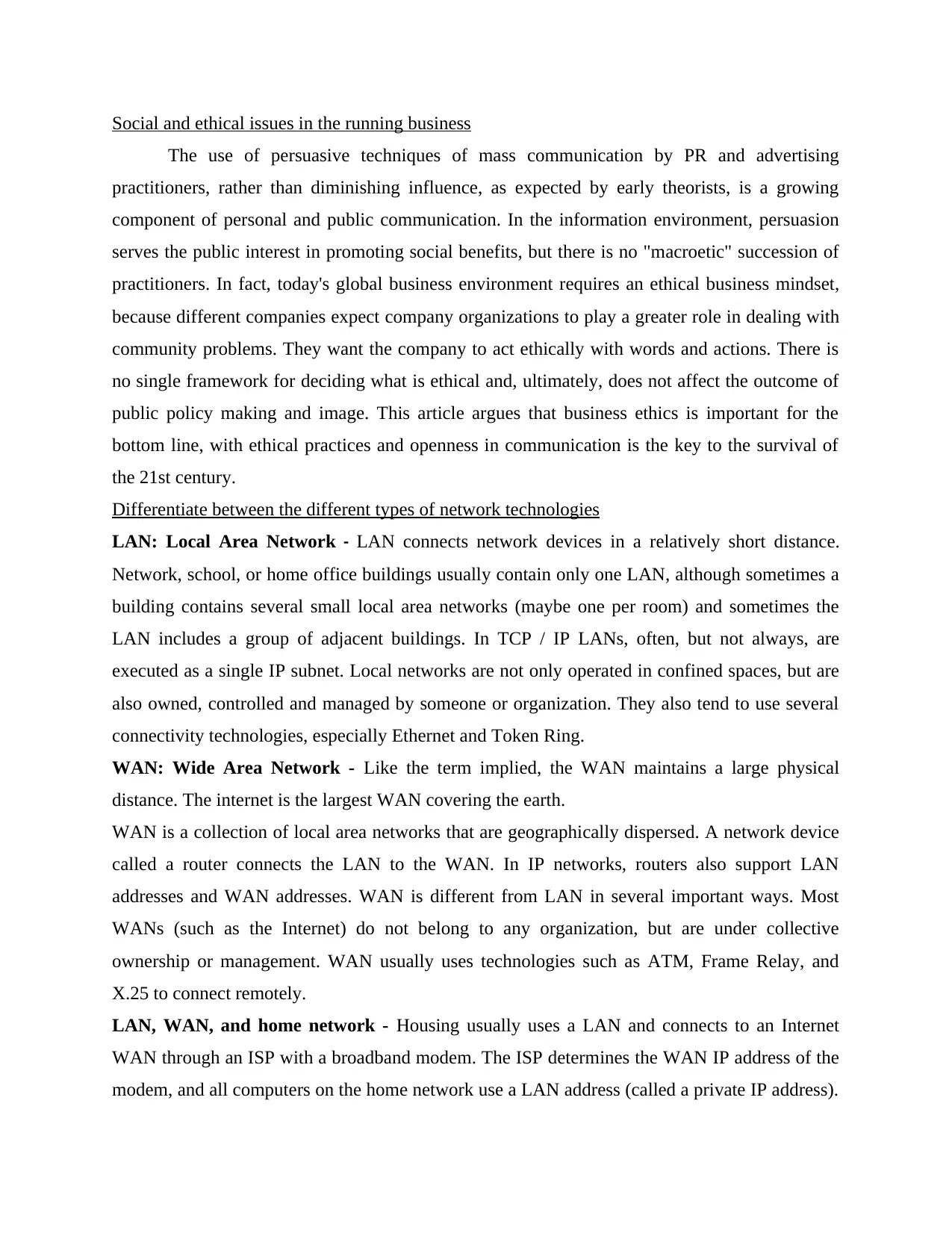
Social and ethical issues in the running business
The use of persuasive techniques of mass communication by PR and advertising
practitioners, rather than diminishing influence, as expected by early theorists, is a growing
component of personal and public communication. In the information environment, persuasion
serves the public interest in promoting social benefits, but there is no "macroetic" succession of
practitioners. In fact, today's global business environment requires an ethical business mindset,
because different companies expect company organizations to play a greater role in dealing with
community problems. They want the company to act ethically with words and actions. There is
no single framework for deciding what is ethical and, ultimately, does not affect the outcome of
public policy making and image. This article argues that business ethics is important for the
bottom line, with ethical practices and openness in communication is the key to the survival of
the 21st century.
Differentiate between the different types of network technologies
LAN: Local Area Network - LAN connects network devices in a relatively short distance.
Network, school, or home office buildings usually contain only one LAN, although sometimes a
building contains several small local area networks (maybe one per room) and sometimes the
LAN includes a group of adjacent buildings. In TCP / IP LANs, often, but not always, are
executed as a single IP subnet. Local networks are not only operated in confined spaces, but are
also owned, controlled and managed by someone or organization. They also tend to use several
connectivity technologies, especially Ethernet and Token Ring.
WAN: Wide Area Network - Like the term implied, the WAN maintains a large physical
distance. The internet is the largest WAN covering the earth.
WAN is a collection of local area networks that are geographically dispersed. A network device
called a router connects the LAN to the WAN. In IP networks, routers also support LAN
addresses and WAN addresses. WAN is different from LAN in several important ways. Most
WANs (such as the Internet) do not belong to any organization, but are under collective
ownership or management. WAN usually uses technologies such as ATM, Frame Relay, and
X.25 to connect remotely.
LAN, WAN, and home network - Housing usually uses a LAN and connects to an Internet
WAN through an ISP with a broadband modem. The ISP determines the WAN IP address of the
modem, and all computers on the home network use a LAN address (called a private IP address).
The use of persuasive techniques of mass communication by PR and advertising
practitioners, rather than diminishing influence, as expected by early theorists, is a growing
component of personal and public communication. In the information environment, persuasion
serves the public interest in promoting social benefits, but there is no "macroetic" succession of
practitioners. In fact, today's global business environment requires an ethical business mindset,
because different companies expect company organizations to play a greater role in dealing with
community problems. They want the company to act ethically with words and actions. There is
no single framework for deciding what is ethical and, ultimately, does not affect the outcome of
public policy making and image. This article argues that business ethics is important for the
bottom line, with ethical practices and openness in communication is the key to the survival of
the 21st century.
Differentiate between the different types of network technologies
LAN: Local Area Network - LAN connects network devices in a relatively short distance.
Network, school, or home office buildings usually contain only one LAN, although sometimes a
building contains several small local area networks (maybe one per room) and sometimes the
LAN includes a group of adjacent buildings. In TCP / IP LANs, often, but not always, are
executed as a single IP subnet. Local networks are not only operated in confined spaces, but are
also owned, controlled and managed by someone or organization. They also tend to use several
connectivity technologies, especially Ethernet and Token Ring.
WAN: Wide Area Network - Like the term implied, the WAN maintains a large physical
distance. The internet is the largest WAN covering the earth.
WAN is a collection of local area networks that are geographically dispersed. A network device
called a router connects the LAN to the WAN. In IP networks, routers also support LAN
addresses and WAN addresses. WAN is different from LAN in several important ways. Most
WANs (such as the Internet) do not belong to any organization, but are under collective
ownership or management. WAN usually uses technologies such as ATM, Frame Relay, and
X.25 to connect remotely.
LAN, WAN, and home network - Housing usually uses a LAN and connects to an Internet
WAN through an ISP with a broadband modem. The ISP determines the WAN IP address of the
modem, and all computers on the home network use a LAN address (called a private IP address).
Paraphrase This Document
Need a fresh take? Get an instant paraphrase of this document with our AI Paraphraser
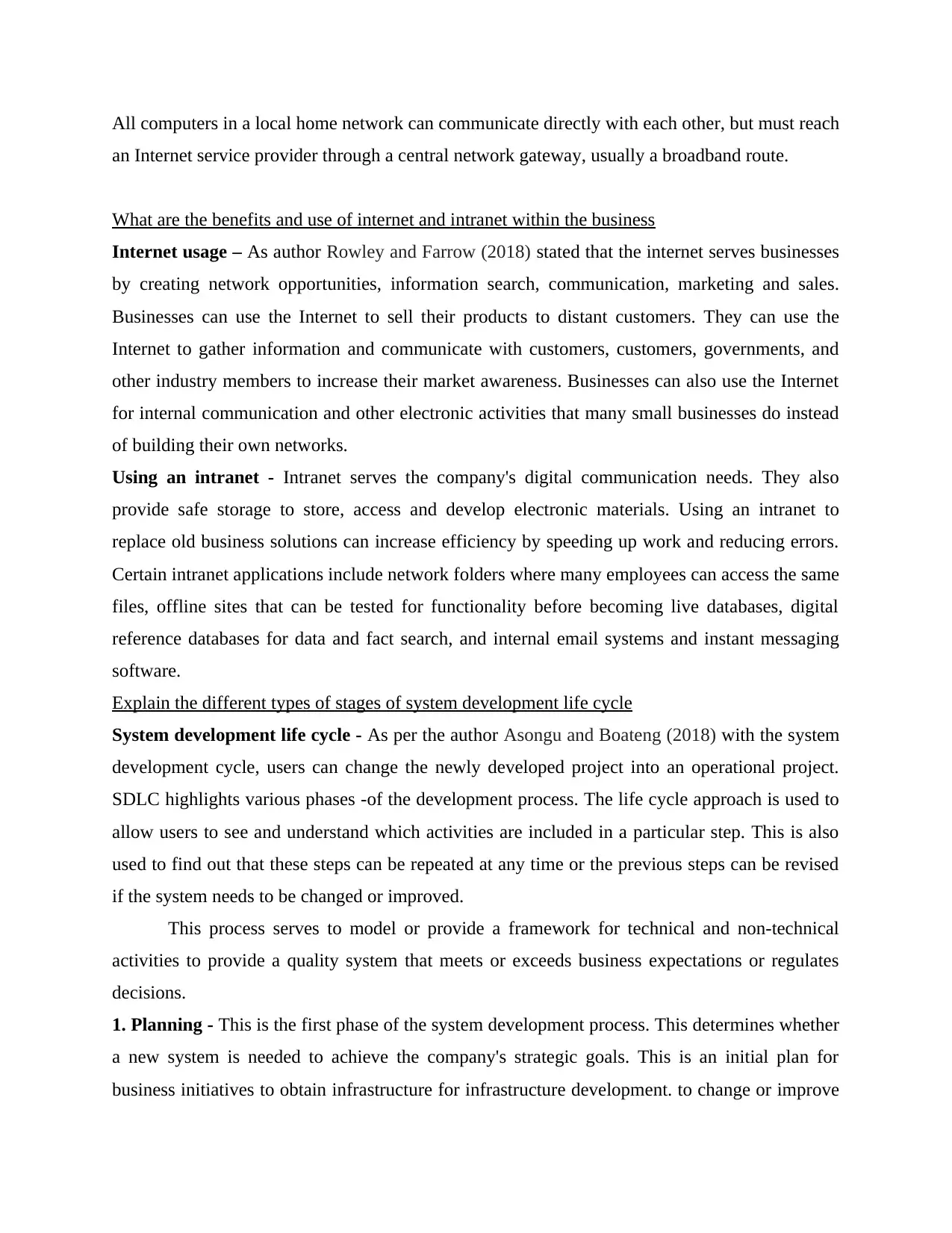
All computers in a local home network can communicate directly with each other, but must reach
an Internet service provider through a central network gateway, usually a broadband route.
What are the benefits and use of internet and intranet within the business
Internet usage – As author Rowley and Farrow (2018) stated that the internet serves businesses
by creating network opportunities, information search, communication, marketing and sales.
Businesses can use the Internet to sell their products to distant customers. They can use the
Internet to gather information and communicate with customers, customers, governments, and
other industry members to increase their market awareness. Businesses can also use the Internet
for internal communication and other electronic activities that many small businesses do instead
of building their own networks.
Using an intranet - Intranet serves the company's digital communication needs. They also
provide safe storage to store, access and develop electronic materials. Using an intranet to
replace old business solutions can increase efficiency by speeding up work and reducing errors.
Certain intranet applications include network folders where many employees can access the same
files, offline sites that can be tested for functionality before becoming live databases, digital
reference databases for data and fact search, and internal email systems and instant messaging
software.
Explain the different types of stages of system development life cycle
System development life cycle - As per the author Asongu and Boateng (2018) with the system
development cycle, users can change the newly developed project into an operational project.
SDLC highlights various phases -of the development process. The life cycle approach is used to
allow users to see and understand which activities are included in a particular step. This is also
used to find out that these steps can be repeated at any time or the previous steps can be revised
if the system needs to be changed or improved.
This process serves to model or provide a framework for technical and non-technical
activities to provide a quality system that meets or exceeds business expectations or regulates
decisions.
1. Planning - This is the first phase of the system development process. This determines whether
a new system is needed to achieve the company's strategic goals. This is an initial plan for
business initiatives to obtain infrastructure for infrastructure development. to change or improve
an Internet service provider through a central network gateway, usually a broadband route.
What are the benefits and use of internet and intranet within the business
Internet usage – As author Rowley and Farrow (2018) stated that the internet serves businesses
by creating network opportunities, information search, communication, marketing and sales.
Businesses can use the Internet to sell their products to distant customers. They can use the
Internet to gather information and communicate with customers, customers, governments, and
other industry members to increase their market awareness. Businesses can also use the Internet
for internal communication and other electronic activities that many small businesses do instead
of building their own networks.
Using an intranet - Intranet serves the company's digital communication needs. They also
provide safe storage to store, access and develop electronic materials. Using an intranet to
replace old business solutions can increase efficiency by speeding up work and reducing errors.
Certain intranet applications include network folders where many employees can access the same
files, offline sites that can be tested for functionality before becoming live databases, digital
reference databases for data and fact search, and internal email systems and instant messaging
software.
Explain the different types of stages of system development life cycle
System development life cycle - As per the author Asongu and Boateng (2018) with the system
development cycle, users can change the newly developed project into an operational project.
SDLC highlights various phases -of the development process. The life cycle approach is used to
allow users to see and understand which activities are included in a particular step. This is also
used to find out that these steps can be repeated at any time or the previous steps can be revised
if the system needs to be changed or improved.
This process serves to model or provide a framework for technical and non-technical
activities to provide a quality system that meets or exceeds business expectations or regulates
decisions.
1. Planning - This is the first phase of the system development process. This determines whether
a new system is needed to achieve the company's strategic goals. This is an initial plan for
business initiatives to obtain infrastructure for infrastructure development. to change or improve
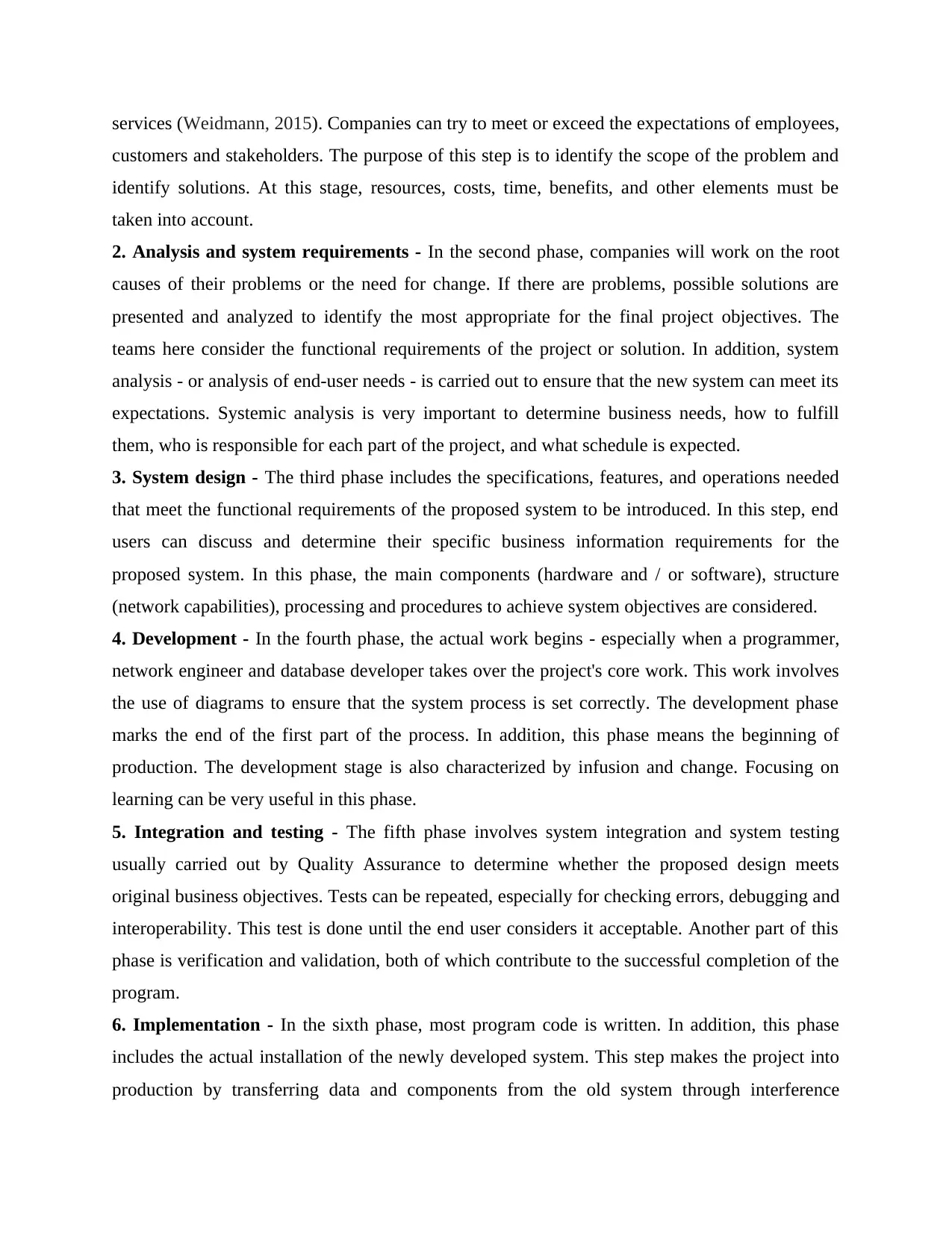
services (Weidmann, 2015). Companies can try to meet or exceed the expectations of employees,
customers and stakeholders. The purpose of this step is to identify the scope of the problem and
identify solutions. At this stage, resources, costs, time, benefits, and other elements must be
taken into account.
2. Analysis and system requirements - In the second phase, companies will work on the root
causes of their problems or the need for change. If there are problems, possible solutions are
presented and analyzed to identify the most appropriate for the final project objectives. The
teams here consider the functional requirements of the project or solution. In addition, system
analysis - or analysis of end-user needs - is carried out to ensure that the new system can meet its
expectations. Systemic analysis is very important to determine business needs, how to fulfill
them, who is responsible for each part of the project, and what schedule is expected.
3. System design - The third phase includes the specifications, features, and operations needed
that meet the functional requirements of the proposed system to be introduced. In this step, end
users can discuss and determine their specific business information requirements for the
proposed system. In this phase, the main components (hardware and / or software), structure
(network capabilities), processing and procedures to achieve system objectives are considered.
4. Development - In the fourth phase, the actual work begins - especially when a programmer,
network engineer and database developer takes over the project's core work. This work involves
the use of diagrams to ensure that the system process is set correctly. The development phase
marks the end of the first part of the process. In addition, this phase means the beginning of
production. The development stage is also characterized by infusion and change. Focusing on
learning can be very useful in this phase.
5. Integration and testing - The fifth phase involves system integration and system testing
usually carried out by Quality Assurance to determine whether the proposed design meets
original business objectives. Tests can be repeated, especially for checking errors, debugging and
interoperability. This test is done until the end user considers it acceptable. Another part of this
phase is verification and validation, both of which contribute to the successful completion of the
program.
6. Implementation - In the sixth phase, most program code is written. In addition, this phase
includes the actual installation of the newly developed system. This step makes the project into
production by transferring data and components from the old system through interference
customers and stakeholders. The purpose of this step is to identify the scope of the problem and
identify solutions. At this stage, resources, costs, time, benefits, and other elements must be
taken into account.
2. Analysis and system requirements - In the second phase, companies will work on the root
causes of their problems or the need for change. If there are problems, possible solutions are
presented and analyzed to identify the most appropriate for the final project objectives. The
teams here consider the functional requirements of the project or solution. In addition, system
analysis - or analysis of end-user needs - is carried out to ensure that the new system can meet its
expectations. Systemic analysis is very important to determine business needs, how to fulfill
them, who is responsible for each part of the project, and what schedule is expected.
3. System design - The third phase includes the specifications, features, and operations needed
that meet the functional requirements of the proposed system to be introduced. In this step, end
users can discuss and determine their specific business information requirements for the
proposed system. In this phase, the main components (hardware and / or software), structure
(network capabilities), processing and procedures to achieve system objectives are considered.
4. Development - In the fourth phase, the actual work begins - especially when a programmer,
network engineer and database developer takes over the project's core work. This work involves
the use of diagrams to ensure that the system process is set correctly. The development phase
marks the end of the first part of the process. In addition, this phase means the beginning of
production. The development stage is also characterized by infusion and change. Focusing on
learning can be very useful in this phase.
5. Integration and testing - The fifth phase involves system integration and system testing
usually carried out by Quality Assurance to determine whether the proposed design meets
original business objectives. Tests can be repeated, especially for checking errors, debugging and
interoperability. This test is done until the end user considers it acceptable. Another part of this
phase is verification and validation, both of which contribute to the successful completion of the
program.
6. Implementation - In the sixth phase, most program code is written. In addition, this phase
includes the actual installation of the newly developed system. This step makes the project into
production by transferring data and components from the old system through interference
⊘ This is a preview!⊘
Do you want full access?
Subscribe today to unlock all pages.

Trusted by 1+ million students worldwide
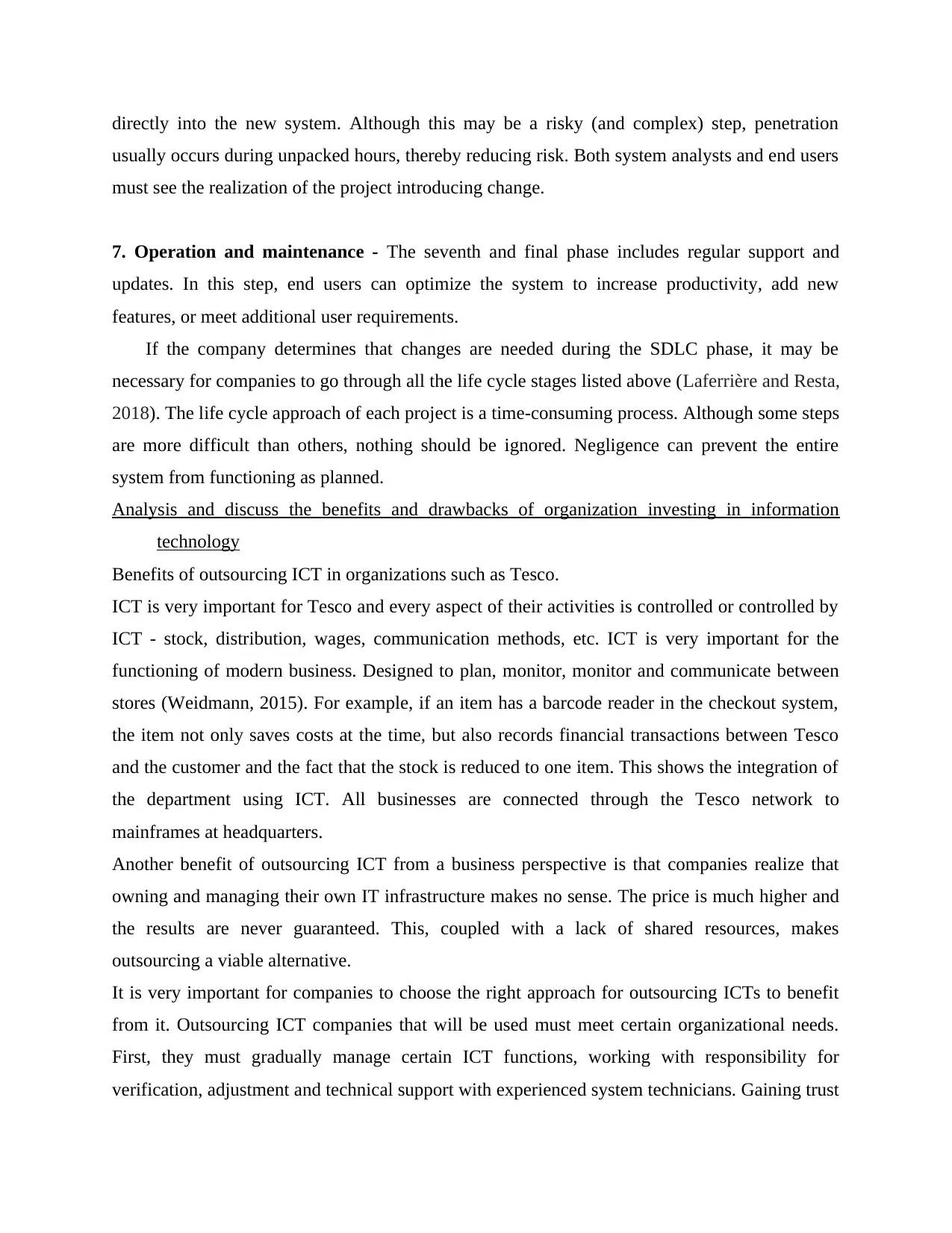
directly into the new system. Although this may be a risky (and complex) step, penetration
usually occurs during unpacked hours, thereby reducing risk. Both system analysts and end users
must see the realization of the project introducing change.
7. Operation and maintenance - The seventh and final phase includes regular support and
updates. In this step, end users can optimize the system to increase productivity, add new
features, or meet additional user requirements.
If the company determines that changes are needed during the SDLC phase, it may be
necessary for companies to go through all the life cycle stages listed above (Laferrière and Resta,
2018). The life cycle approach of each project is a time-consuming process. Although some steps
are more difficult than others, nothing should be ignored. Negligence can prevent the entire
system from functioning as planned.
Analysis and discuss the benefits and drawbacks of organization investing in information
technology
Benefits of outsourcing ICT in organizations such as Tesco.
ICT is very important for Tesco and every aspect of their activities is controlled or controlled by
ICT - stock, distribution, wages, communication methods, etc. ICT is very important for the
functioning of modern business. Designed to plan, monitor, monitor and communicate between
stores (Weidmann, 2015). For example, if an item has a barcode reader in the checkout system,
the item not only saves costs at the time, but also records financial transactions between Tesco
and the customer and the fact that the stock is reduced to one item. This shows the integration of
the department using ICT. All businesses are connected through the Tesco network to
mainframes at headquarters.
Another benefit of outsourcing ICT from a business perspective is that companies realize that
owning and managing their own IT infrastructure makes no sense. The price is much higher and
the results are never guaranteed. This, coupled with a lack of shared resources, makes
outsourcing a viable alternative.
It is very important for companies to choose the right approach for outsourcing ICTs to benefit
from it. Outsourcing ICT companies that will be used must meet certain organizational needs.
First, they must gradually manage certain ICT functions, working with responsibility for
verification, adjustment and technical support with experienced system technicians. Gaining trust
usually occurs during unpacked hours, thereby reducing risk. Both system analysts and end users
must see the realization of the project introducing change.
7. Operation and maintenance - The seventh and final phase includes regular support and
updates. In this step, end users can optimize the system to increase productivity, add new
features, or meet additional user requirements.
If the company determines that changes are needed during the SDLC phase, it may be
necessary for companies to go through all the life cycle stages listed above (Laferrière and Resta,
2018). The life cycle approach of each project is a time-consuming process. Although some steps
are more difficult than others, nothing should be ignored. Negligence can prevent the entire
system from functioning as planned.
Analysis and discuss the benefits and drawbacks of organization investing in information
technology
Benefits of outsourcing ICT in organizations such as Tesco.
ICT is very important for Tesco and every aspect of their activities is controlled or controlled by
ICT - stock, distribution, wages, communication methods, etc. ICT is very important for the
functioning of modern business. Designed to plan, monitor, monitor and communicate between
stores (Weidmann, 2015). For example, if an item has a barcode reader in the checkout system,
the item not only saves costs at the time, but also records financial transactions between Tesco
and the customer and the fact that the stock is reduced to one item. This shows the integration of
the department using ICT. All businesses are connected through the Tesco network to
mainframes at headquarters.
Another benefit of outsourcing ICT from a business perspective is that companies realize that
owning and managing their own IT infrastructure makes no sense. The price is much higher and
the results are never guaranteed. This, coupled with a lack of shared resources, makes
outsourcing a viable alternative.
It is very important for companies to choose the right approach for outsourcing ICTs to benefit
from it. Outsourcing ICT companies that will be used must meet certain organizational needs.
First, they must gradually manage certain ICT functions, working with responsibility for
verification, adjustment and technical support with experienced system technicians. Gaining trust
Paraphrase This Document
Need a fresh take? Get an instant paraphrase of this document with our AI Paraphraser
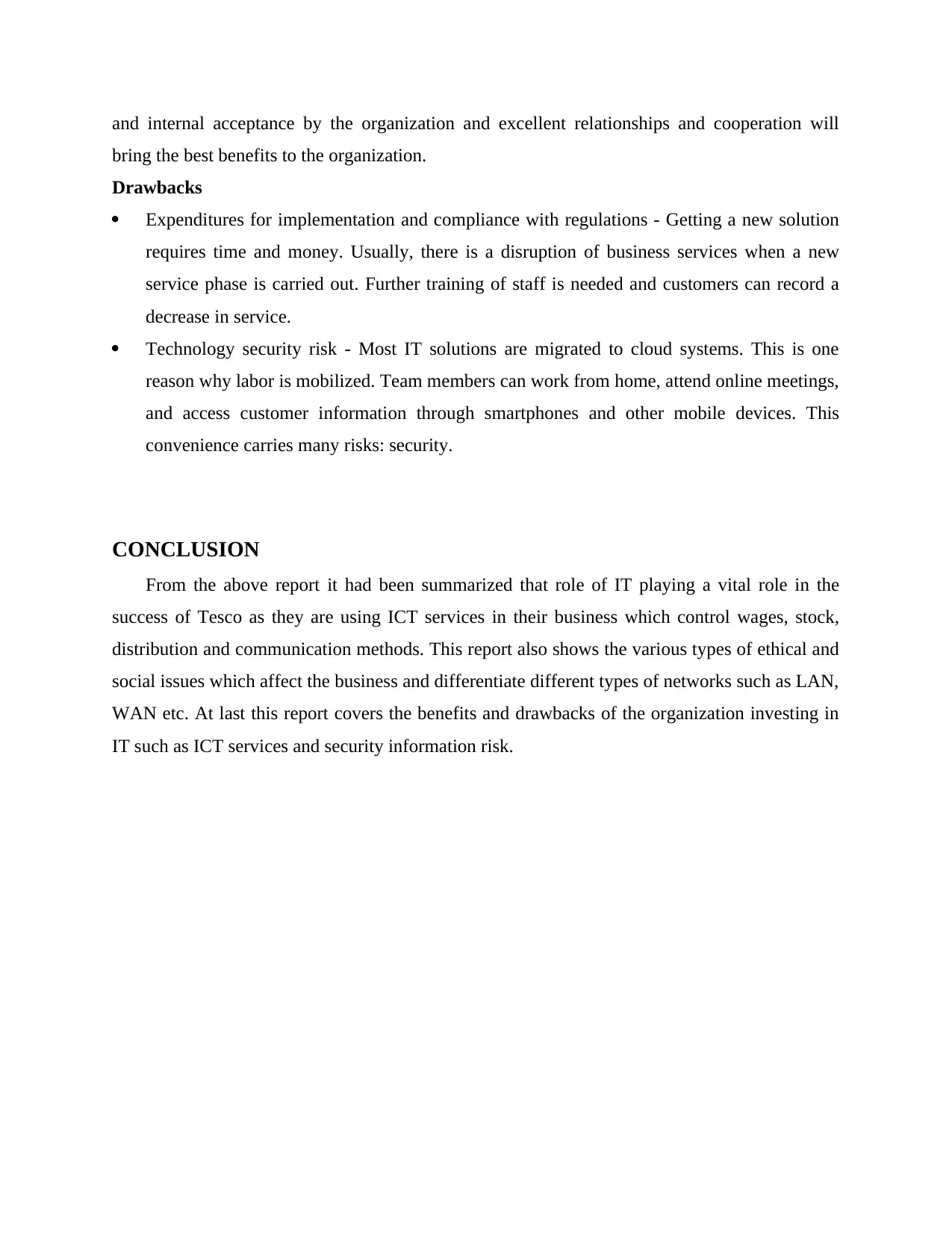
and internal acceptance by the organization and excellent relationships and cooperation will
bring the best benefits to the organization.
Drawbacks
Expenditures for implementation and compliance with regulations - Getting a new solution
requires time and money. Usually, there is a disruption of business services when a new
service phase is carried out. Further training of staff is needed and customers can record a
decrease in service.
Technology security risk - Most IT solutions are migrated to cloud systems. This is one
reason why labor is mobilized. Team members can work from home, attend online meetings,
and access customer information through smartphones and other mobile devices. This
convenience carries many risks: security.
CONCLUSION
From the above report it had been summarized that role of IT playing a vital role in the
success of Tesco as they are using ICT services in their business which control wages, stock,
distribution and communication methods. This report also shows the various types of ethical and
social issues which affect the business and differentiate different types of networks such as LAN,
WAN etc. At last this report covers the benefits and drawbacks of the organization investing in
IT such as ICT services and security information risk.
bring the best benefits to the organization.
Drawbacks
Expenditures for implementation and compliance with regulations - Getting a new solution
requires time and money. Usually, there is a disruption of business services when a new
service phase is carried out. Further training of staff is needed and customers can record a
decrease in service.
Technology security risk - Most IT solutions are migrated to cloud systems. This is one
reason why labor is mobilized. Team members can work from home, attend online meetings,
and access customer information through smartphones and other mobile devices. This
convenience carries many risks: security.
CONCLUSION
From the above report it had been summarized that role of IT playing a vital role in the
success of Tesco as they are using ICT services in their business which control wages, stock,
distribution and communication methods. This report also shows the various types of ethical and
social issues which affect the business and differentiate different types of networks such as LAN,
WAN etc. At last this report covers the benefits and drawbacks of the organization investing in
IT such as ICT services and security information risk.
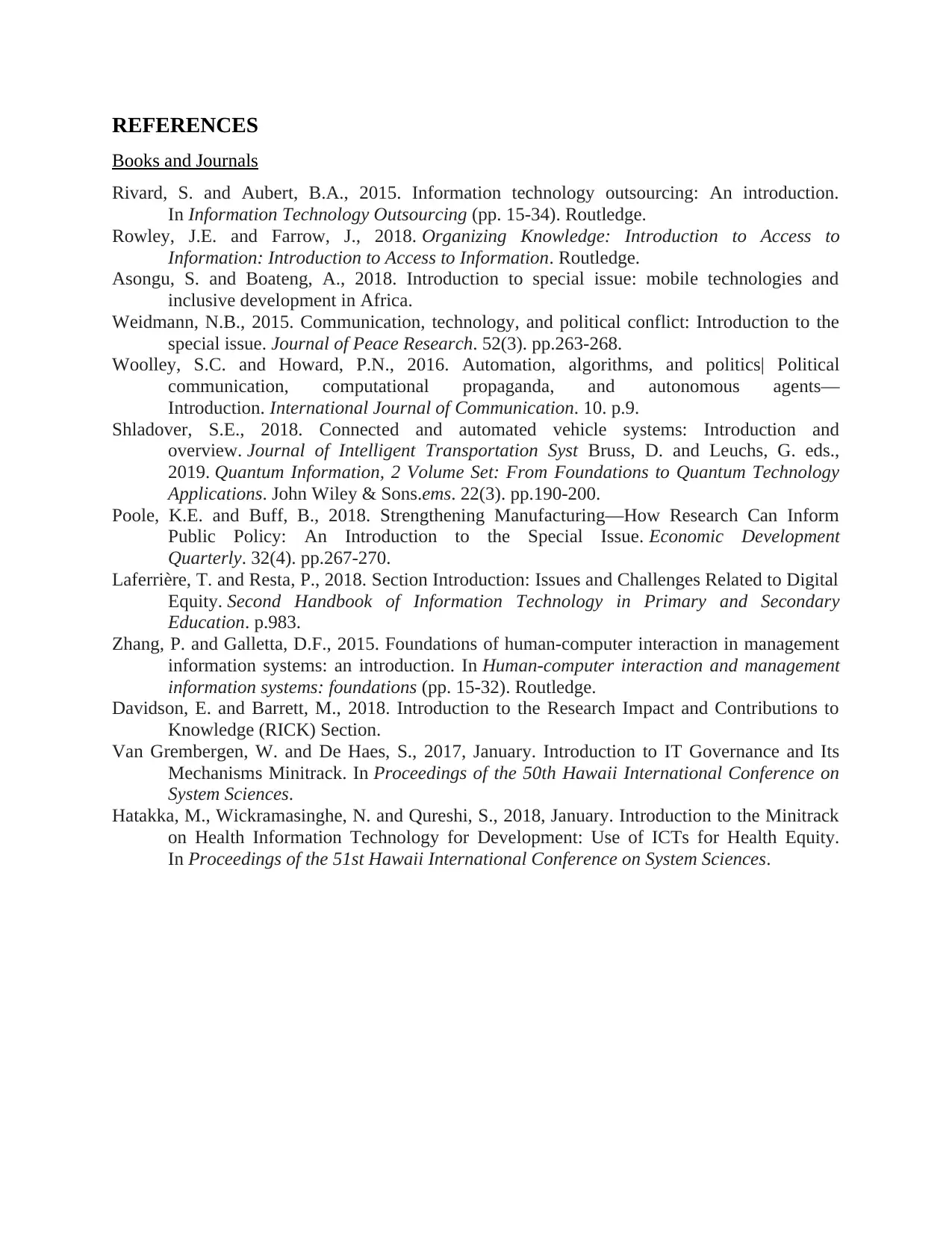
REFERENCES
Books and Journals
Rivard, S. and Aubert, B.A., 2015. Information technology outsourcing: An introduction.
In Information Technology Outsourcing (pp. 15-34). Routledge.
Rowley, J.E. and Farrow, J., 2018. Organizing Knowledge: Introduction to Access to
Information: Introduction to Access to Information. Routledge.
Asongu, S. and Boateng, A., 2018. Introduction to special issue: mobile technologies and
inclusive development in Africa.
Weidmann, N.B., 2015. Communication, technology, and political conflict: Introduction to the
special issue. Journal of Peace Research. 52(3). pp.263-268.
Woolley, S.C. and Howard, P.N., 2016. Automation, algorithms, and politics| Political
communication, computational propaganda, and autonomous agents—
Introduction. International Journal of Communication. 10. p.9.
Shladover, S.E., 2018. Connected and automated vehicle systems: Introduction and
overview. Journal of Intelligent Transportation Syst Bruss, D. and Leuchs, G. eds.,
2019. Quantum Information, 2 Volume Set: From Foundations to Quantum Technology
Applications. John Wiley & Sons.ems. 22(3). pp.190-200.
Poole, K.E. and Buff, B., 2018. Strengthening Manufacturing—How Research Can Inform
Public Policy: An Introduction to the Special Issue. Economic Development
Quarterly. 32(4). pp.267-270.
Laferrière, T. and Resta, P., 2018. Section Introduction: Issues and Challenges Related to Digital
Equity. Second Handbook of Information Technology in Primary and Secondary
Education. p.983.
Zhang, P. and Galletta, D.F., 2015. Foundations of human-computer interaction in management
information systems: an introduction. In Human-computer interaction and management
information systems: foundations (pp. 15-32). Routledge.
Davidson, E. and Barrett, M., 2018. Introduction to the Research Impact and Contributions to
Knowledge (RICK) Section.
Van Grembergen, W. and De Haes, S., 2017, January. Introduction to IT Governance and Its
Mechanisms Minitrack. In Proceedings of the 50th Hawaii International Conference on
System Sciences.
Hatakka, M., Wickramasinghe, N. and Qureshi, S., 2018, January. Introduction to the Minitrack
on Health Information Technology for Development: Use of ICTs for Health Equity.
In Proceedings of the 51st Hawaii International Conference on System Sciences.
Books and Journals
Rivard, S. and Aubert, B.A., 2015. Information technology outsourcing: An introduction.
In Information Technology Outsourcing (pp. 15-34). Routledge.
Rowley, J.E. and Farrow, J., 2018. Organizing Knowledge: Introduction to Access to
Information: Introduction to Access to Information. Routledge.
Asongu, S. and Boateng, A., 2018. Introduction to special issue: mobile technologies and
inclusive development in Africa.
Weidmann, N.B., 2015. Communication, technology, and political conflict: Introduction to the
special issue. Journal of Peace Research. 52(3). pp.263-268.
Woolley, S.C. and Howard, P.N., 2016. Automation, algorithms, and politics| Political
communication, computational propaganda, and autonomous agents—
Introduction. International Journal of Communication. 10. p.9.
Shladover, S.E., 2018. Connected and automated vehicle systems: Introduction and
overview. Journal of Intelligent Transportation Syst Bruss, D. and Leuchs, G. eds.,
2019. Quantum Information, 2 Volume Set: From Foundations to Quantum Technology
Applications. John Wiley & Sons.ems. 22(3). pp.190-200.
Poole, K.E. and Buff, B., 2018. Strengthening Manufacturing—How Research Can Inform
Public Policy: An Introduction to the Special Issue. Economic Development
Quarterly. 32(4). pp.267-270.
Laferrière, T. and Resta, P., 2018. Section Introduction: Issues and Challenges Related to Digital
Equity. Second Handbook of Information Technology in Primary and Secondary
Education. p.983.
Zhang, P. and Galletta, D.F., 2015. Foundations of human-computer interaction in management
information systems: an introduction. In Human-computer interaction and management
information systems: foundations (pp. 15-32). Routledge.
Davidson, E. and Barrett, M., 2018. Introduction to the Research Impact and Contributions to
Knowledge (RICK) Section.
Van Grembergen, W. and De Haes, S., 2017, January. Introduction to IT Governance and Its
Mechanisms Minitrack. In Proceedings of the 50th Hawaii International Conference on
System Sciences.
Hatakka, M., Wickramasinghe, N. and Qureshi, S., 2018, January. Introduction to the Minitrack
on Health Information Technology for Development: Use of ICTs for Health Equity.
In Proceedings of the 51st Hawaii International Conference on System Sciences.
⊘ This is a preview!⊘
Do you want full access?
Subscribe today to unlock all pages.

Trusted by 1+ million students worldwide
1 out of 9
Related Documents
Your All-in-One AI-Powered Toolkit for Academic Success.
+13062052269
info@desklib.com
Available 24*7 on WhatsApp / Email
![[object Object]](/_next/static/media/star-bottom.7253800d.svg)
Unlock your academic potential
Copyright © 2020–2025 A2Z Services. All Rights Reserved. Developed and managed by ZUCOL.




